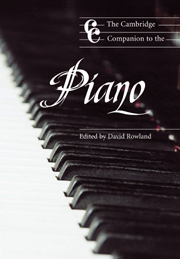Book contents
- Frontmatter
- Introduction
- Part one Pianos and pianists
- Part two Repertory
- 7 Repertory and canon
- 8 The music of the early pianists (to c.1830)
- 9 Piano music for concert hall and salon c.1830–1900
- 10 Nationalism
- 11 New horizons in the twentieth century
- 12 Ragtime, blues, jazz and popular music
- Glossary
- Notes
- Select bibliography
- Index
12 - Ragtime, blues, jazz and popular music
from Part two - Repertory
Published online by Cambridge University Press: 28 September 2011
- Frontmatter
- Introduction
- Part one Pianos and pianists
- Part two Repertory
- 7 Repertory and canon
- 8 The music of the early pianists (to c.1830)
- 9 Piano music for concert hall and salon c.1830–1900
- 10 Nationalism
- 11 New horizons in the twentieth century
- 12 Ragtime, blues, jazz and popular music
- Glossary
- Notes
- Select bibliography
- Index
Summary
Throughout the multifarious developments in the field of composition during the twentieth century, the piano has clearly retained its high profile, and its central role in European-style music making. The divide between broadly ‘popular’ and so-called ‘serious’ music, however, has widened irrevocably and, even though the boundaries may fluctuate from time to time, this has come about through changes in Western society.
It is undeniable that the distinct personality of twentieth-century popular music reflects the stylistic contribution of African–American idioms. While such idioms originally developed unhindered, the last one hundred years have seen a gradual but remarkable takeover of the popular field. The arrival of a powerful sheet-music publishing industry was followed (in chronological order of their greatest impact) by radio, sound films, commercial recording and television. Although in each medium the powers that be initially resisted black composers and performers, they eventually capitulated and thereafter played a crucial role in spreading previous minority preferences among the mainstream.
Further consideration of this fascinating process lies outside the scope of the present volume, but two other factors must be borne in mind. Firstly, those responsible for each musical innovation were not merely the elite who form the breeding ground for innovation in any artistic sphere, but a performing minority within a racial minority. Thus, despite the accelerated rate of change brought about by technological developments, the dissemination of musical innovation was a three-stage process.
- Type
- Chapter
- Information
- The Cambridge Companion to the Piano , pp. 209 - 224Publisher: Cambridge University PressPrint publication year: 1998



